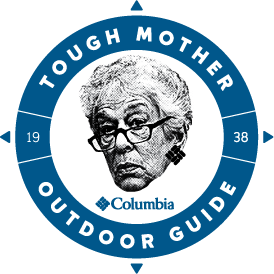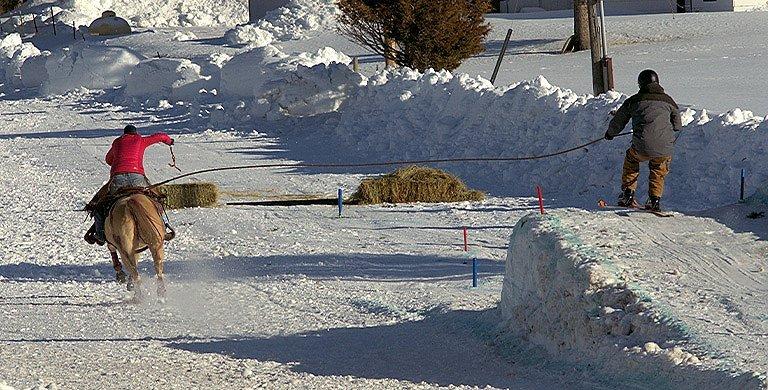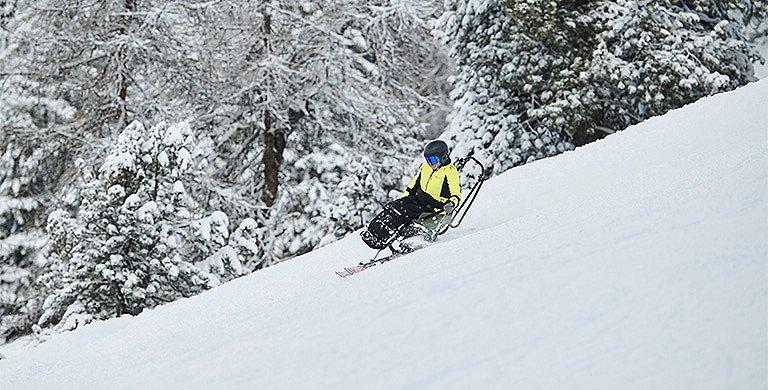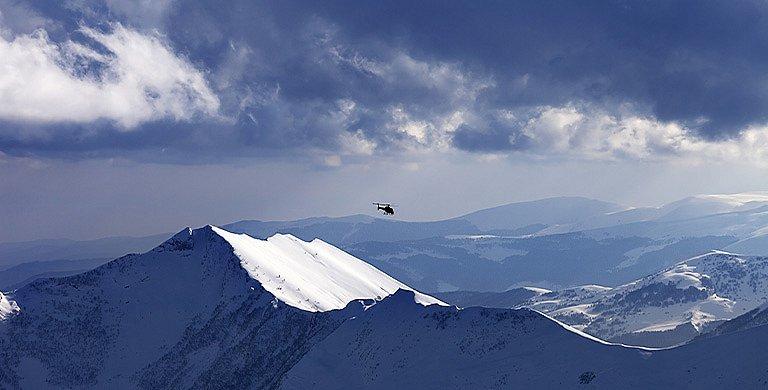SKI & SNOW
Snow Safety Courses Save Lives: Why Everyone Should Take an Avalanche Safety Course
For many of us, the world’s a snow globe, ready for adventure. But, beneath its sparkle lies a danger far worse than frostbite: avalanches. Don't just play in the snow, learn how to survive it.
BY: NANCY BOUCHARD
Around the world, people flock to mountains, whether to ski, snowshoe, snowmobile, or simply enjoy the outdoors. But these beautiful landscapes come with dangers that many of us don't anticipate. Avalanches are unpredictable, deadly, and, unfortunately, more common than many realize. According to experts, understanding avalanche safety is not just for professionals but for anyone who spends time in the snow, whether they work, play, or live in these snow-swept spaces.
An avalanche is a fast-moving mass of snow, ice, and debris that tumbles down a slope, triggered by the weight of the snow or external forces like a skier, snowboarder, snowmobiler, or changing weather. Heavy snowfall, wind, rain and freeze-thaw cycles are all significant factors in avalanche formation. Over the last decade, avalanches claimed an average of 27 lives per winter in the United States. European countries see 100 to 150 fatalities annually, with Switzerland, France and Austria having the highest numbers. Countries like Canada, Japan, Pakistan, Norway, and New Zealand—basically anywhere where people live and recreate in snowy mountains—also report fatalities.
Avalanches aren't just a risk in remote mountains—they can strike roads, villages, and even hotels and shops. Slopes between 30 and 45 degrees are most prone to slides but change in weather can quickly turn these parameters upside down. Experts stress the importance of understanding terrain, snowpack, and weather conditions, and always checking avalanche forecasts before heading out. Even professionals can make deadly mistakes. It’s a constant battle between forecasting and increased backcountry traffic, with a dose of luck thrown in. While it offers little solace to victims and their families, each incident is thoroughly investigated, and the information shared helps raise awareness and improve safety. Resources like the Colorado Avalanche Information Center (CAIC) provide vital data, forecasts, and educational tools to keep everyone safer in the snow. If you live or are traveling in a mountainous, snowy environment, chances are there’s an avalanche forecasting group working to keep you informed.
Basic equipment for travel in avalanche terrain includes a shovel, probe, beacon, and sometimes a backpack airbag—each of which requires some level of training to use effectively. In addition, it's crucial to wear apparel that keeps you warm, dry, and comfortable in cold, snowy conditions. Dressing in layers will help prevent overheating during physical activity, while emergency items like extra socks and gloves, a puffy jacket, and waterproof gear are essential components of any smart backcountry traveler’s winter kit.
We spoke with two avalanche safety experts, Ethan Greene, director of the Colorado Avalanche Information Center, and Kenzie Carson, an avalanche educator and guide, about the importance of avalanche education.
An avalanche is a fast-moving mass of snow, ice, and debris that tumbles down a slope, triggered by the weight of the snow or external forces like a skier, snowboarder, snowmobiler, or changing weather. Heavy snowfall, wind, rain and freeze-thaw cycles are all significant factors in avalanche formation. Over the last decade, avalanches claimed an average of 27 lives per winter in the United States. European countries see 100 to 150 fatalities annually, with Switzerland, France and Austria having the highest numbers. Countries like Canada, Japan, Pakistan, Norway, and New Zealand—basically anywhere where people live and recreate in snowy mountains—also report fatalities.
Avalanches aren't just a risk in remote mountains—they can strike roads, villages, and even hotels and shops. Slopes between 30 and 45 degrees are most prone to slides but change in weather can quickly turn these parameters upside down. Experts stress the importance of understanding terrain, snowpack, and weather conditions, and always checking avalanche forecasts before heading out. Even professionals can make deadly mistakes. It’s a constant battle between forecasting and increased backcountry traffic, with a dose of luck thrown in. While it offers little solace to victims and their families, each incident is thoroughly investigated, and the information shared helps raise awareness and improve safety. Resources like the Colorado Avalanche Information Center (CAIC) provide vital data, forecasts, and educational tools to keep everyone safer in the snow. If you live or are traveling in a mountainous, snowy environment, chances are there’s an avalanche forecasting group working to keep you informed.
Basic equipment for travel in avalanche terrain includes a shovel, probe, beacon, and sometimes a backpack airbag—each of which requires some level of training to use effectively. In addition, it's crucial to wear apparel that keeps you warm, dry, and comfortable in cold, snowy conditions. Dressing in layers will help prevent overheating during physical activity, while emergency items like extra socks and gloves, a puffy jacket, and waterproof gear are essential components of any smart backcountry traveler’s winter kit.
We spoke with two avalanche safety experts, Ethan Greene, director of the Colorado Avalanche Information Center, and Kenzie Carson, an avalanche educator and guide, about the importance of avalanche education.
Understanding the Risk: Avalanche Awareness Saves Lives
There are naturally occurring avalanches, but if you are recreating in the snow in the wrong conditions, you or someone else could trigger a slide. "Eighty to ninety percent of avalanches are human caused," says Ethan Greene. "Most of the fatal accidents in the U.S. are triggered by the victim or someone in their party." He emphasizes that this statistic highlights the need for education to help people make informed decisions about their safety. Greene's decades of experience in the avalanche world—from ski patrolling to backcountry forecasting—underscores the need for widespread education. "You have to understand avalanches and conditions before you go into avalanche terrain," Greene explains. "Even if you’re just out for a casual snowshoe, it's crucial to know where avalanches can occur."
While skiers and snowmobilers are often the focus, Greene points out that avalanches don't discriminate based on activity. “It’s not just about recreation. Avalanches can affect neighborhoods, homes, and even public buildings. This is why everyone, whether you’re a local or a tourist, should know avalanche basics."
While skiers and snowmobilers are often the focus, Greene points out that avalanches don't discriminate based on activity. “It’s not just about recreation. Avalanches can affect neighborhoods, homes, and even public buildings. This is why everyone, whether you’re a local or a tourist, should know avalanche basics."
Skiers Are Not the Only People at Risk
The truth is that snow slides impact a wide range of outdoor activities. Greene points out that avalanche accidents often happen not just while people are engaging in the "main" avalanche-prone activity such as skiing or ice climbing. "People go snowshoeing or hiking in avalanche terrain, but they don’t recognize the danger. Even a small slope can slide if the conditions are right."
Carson adds that snowmobilers and other motorized sports enthusiasts are also at risk. “People don’t realize how snowmobiles interact with terrain differently than skis or snowshoes,” she says. "A snowmobile might trigger an avalanche that a skier wouldn't. Everyone in the backcountry needs to be educated, regardless of the activity."
Carson adds that snowmobilers and other motorized sports enthusiasts are also at risk. “People don’t realize how snowmobiles interact with terrain differently than skis or snowshoes,” she says. "A snowmobile might trigger an avalanche that a skier wouldn't. Everyone in the backcountry needs to be educated, regardless of the activity."
A Foundation of Knowledge
Both experts agree that an avalanche safety course is a good first step for people planning on spending time in avalanche-prone areas. Kenzie Carson, who works with Montana State University and the Friends of Gallatin National Forest Avalanche Center, explains that courses are designed to help you understand risk, terrain, and the snow conditions that trigger avalanches. "The 'Know Before You Go’ program is perfect for anyone who lives in a mountainous environment with snow on the ground," Carson says. “These courses, often free or donation-based, introduce people to the basic concepts of avalanche awareness--terrain identification, risk assessment, and how to gather information.”
Carson stresses the importance of recognizing avalanche terrain. "Many people don’t realize how small of a slope can trigger an avalanche. It could be a short slope, less than 100 feet, but if it has the right snow conditions and steepness, it can be dangerous."
Carson stresses the importance of recognizing avalanche terrain. "Many people don’t realize how small of a slope can trigger an avalanche. It could be a short slope, less than 100 feet, but if it has the right snow conditions and steepness, it can be dangerous."
Understanding the Courses: Levels of Education
For those looking to go deeper into avalanche safety, there are structured courses. A Level 1 Avalanche Course teaches you how to assess avalanche risk, understand terrain, and make go/no-go decisions. "Level 1 is about understanding the decision-making process and getting familiar with your risk tolerance," Carson says. "It’s not black and white. We give people a framework to make informed choices."
For more experienced adventurers, Level 2 courses build on this knowledge, helping individuals’ step into leadership roles and manage teams in avalanche terrain. "Level 2 is about learning how to manage more complex terrain and how to take on leadership in making group decisions," Carson explains.
Both experts agree that rescue training is just as crucial. Greene adds, “Rescue skills are perishable. You need to practice with your equipment—your beacon, shovel, and probe—so you're not learning how to use them in a stressful, emergency situation.”
For more experienced adventurers, Level 2 courses build on this knowledge, helping individuals’ step into leadership roles and manage teams in avalanche terrain. "Level 2 is about learning how to manage more complex terrain and how to take on leadership in making group decisions," Carson explains.
Both experts agree that rescue training is just as crucial. Greene adds, “Rescue skills are perishable. You need to practice with your equipment—your beacon, shovel, and probe—so you're not learning how to use them in a stressful, emergency situation.”
How to Find the Right Course
Choosing the right avalanche education course depends on your goals. Both Greene and Carson recommend seeking courses accredited by reputable organizations, such as the American Avalanche Association (A3). "Look for programs that are associated with a national or international standard," says Greene. "If you're going to invest in a multi-day course, it’s important to make sure it’s offering quality training."
Carson emphasizes the importance of starting with the basics. “If you’re new to avalanche terrain, start with a Know Before You Go awareness session or a Level 1 course. From there, you can build on your knowledge."
Carson emphasizes the importance of starting with the basics. “If you’re new to avalanche terrain, start with a Know Before You Go awareness session or a Level 1 course. From there, you can build on your knowledge."
The Bottom Line: It’s About Making Informed Decisions
Ultimately, avalanche safety is about understanding the risks and learning how to make decisions based on those risks. "It's about situational awareness," Greene concludes. "If you're in avalanche terrain, you need to know when it’s safe to go and when it’s time to turn back. And that decision needs to be based on knowledge, not guesswork."
Carson adds, "Avalanches are unpredictable, but your ability to respond to them doesn't have to be. Training gives you the skills to make better decisions and keep you and your loved ones safer in the mountains."
With a little education, anyone who plays, works, or lives in snowy areas can reduce their risk of being caught in an avalanche and increase their chances of survival. For those who take the time to learn, the mountains can remain as beautiful and awe-inspiring as ever.
Carson adds, "Avalanches are unpredictable, but your ability to respond to them doesn't have to be. Training gives you the skills to make better decisions and keep you and your loved ones safer in the mountains."
With a little education, anyone who plays, works, or lives in snowy areas can reduce their risk of being caught in an avalanche and increase their chances of survival. For those who take the time to learn, the mountains can remain as beautiful and awe-inspiring as ever.
The next time you head out into the snow, stay warm with Columbia’s collection of ski apparel.



